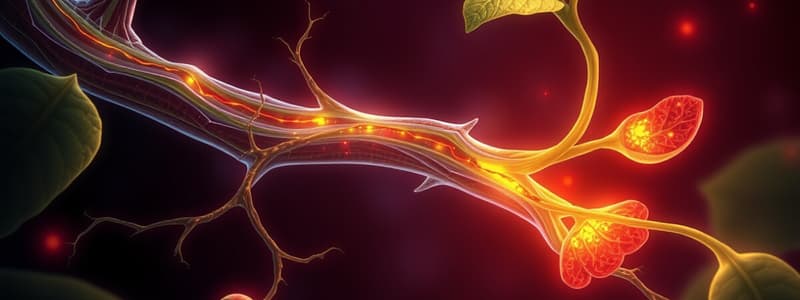Podcast
Questions and Answers
What is the primary function of xylem in plants?
What is the primary function of xylem in plants?
- Provides mechanical support to the plant
- Stores food in roots and stems
- Transports food from leaves to roots
- Conducts water and minerals from roots to other parts (correct)
Which of the following statements is true regarding phloem cells?
Which of the following statements is true regarding phloem cells?
- Phloem transport does not require energy
- Most of the cells are dead except the sclerenchyma
- It consists mainly of xylem vessels and parenchyma
- It transports food from leaves to all parts of the plant (correct)
What distinguishes xylem from phloem in terms of cell viability?
What distinguishes xylem from phloem in terms of cell viability?
- All xylem cells are living
- Most phloem cells are dead, except sclerenchyma
- Most xylem cells are dead, except parenchyma (correct)
- All phloem cells are dead
Which method of transport requires energy?
Which method of transport requires energy?
How does the transport direction differ between xylem and phloem?
How does the transport direction differ between xylem and phloem?
What role do phloem sclerenchyma cells play in plants?
What role do phloem sclerenchyma cells play in plants?
What occurs as a result of diffusion in cell membranes?
What occurs as a result of diffusion in cell membranes?
What is the primary component of a vascular bundle in plants?
What is the primary component of a vascular bundle in plants?
Which of the following is NOT a method by which substances move across the cell membrane?
Which of the following is NOT a method by which substances move across the cell membrane?
Which component of phloem is primarily responsible for food transport?
Which component of phloem is primarily responsible for food transport?
Flashcards are hidden until you start studying
Study Notes
Differences between Xylem and Phloem
- Xylem conducts water and minerals from roots to other plant parts.
- Phloem transports food from leaves to all plant sections.
- Xylem is made up of xylem vessels, tracheids, parenchyma, and sclerenchyma.
- Phloem consists of sieve tube cells, companion cells, phloem parenchyma, and phloem sclerenchyma.
- Most xylem cells are dead, except for parenchyma cells.
- Most phloem cells are alive, with the exception of sclerenchyma.
- Xylem transport is unidirectional, while phloem transport can be bidirectional.
- Transport in xylem does not require energy input.
- Phloem transport requires energy for movement of substances.
Phloem Cell Types
- Phloem parenchyma cells are thin-walled and involved in food transport and storage.
- They are typically located at the ends of sieve tubes.
- Phloem sclerenchyma cells are dead, with thick walls providing mechanical support to the plant.
Functions of Phloem
- Conducts food from leaves to various plant parts, including storage in roots and stems.
- Provides mechanical support through sclerenchyma cells.
Vascular Tissues
- Vascular tissues (xylem and phloem) often form vascular bundles.
- Vascular bundles generally consist of xylem on the inside and phloem on the outside.
Methods of Transport
- Plant transport relies on movement across the selectively permeable cell membrane.
- Substances move via diffusion, osmosis, and active transport.
Diffusion
- Diffusion describes the movement of substances from areas of higher concentration to lower concentration.
- It continues until a uniform concentration is achieved.
- Energy expenditure is not required for diffusion.
- Concentration refers to the amount of a substance within a specific area or mixture.
Studying That Suits You
Use AI to generate personalized quizzes and flashcards to suit your learning preferences.




